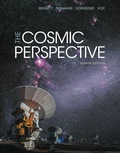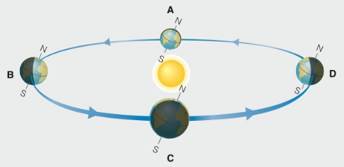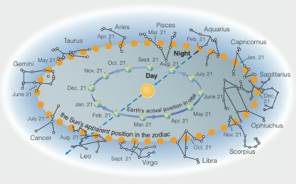
EBK COSMIC PERSPECTIVE, THE
8th Edition
ISBN: 8220101465108
Author: Voit
Publisher: PEARSON
expand_more
expand_more
format_list_bulleted
Textbook Question
Chapter 2, Problem 7VSC
Use the following questions to check your understanding of some of the many types of visual information used in astronomy. For additional practice, try the Chapter 2 Visual Quiz at MasteringAstronomy®.

The figure above is a typical diagram used to describe Earth's seasons.

The figure above (based on Figure 2.14) shows the Sun’s path through the constellations of the zodiac.
7. If the date is April 21, what zodiac constellation will be visible on your meridian at midnight?
a. Leo
b. Aquarius
c. Libra
d. Aries
Expert Solution & Answer
Want to see the full answer?
Check out a sample textbook solution
Students have asked these similar questions
!
Required information
Assume that the magnifier is held close to the eye. Use the standard near point of 25.0 cm to find the angular
magnification. An insect that is 4.10 mm long is placed 10.3 cm from a simple magnifier with a focal length of 13.0 cm.
What is the angular magnification?
2
3
Chapter 2 Solutions
EBK COSMIC PERSPECTIVE, THE
Ch. 2 - Prob. 1VSCCh. 2 - Use the following questions to check your...Ch. 2 - Use the following questions to check your...Ch. 2 - Use the following questions to check your...Ch. 2 - Use the following questions to check your...Ch. 2 - Use the following questions to check your...Ch. 2 - Use the following questions to check your...Ch. 2 - Use the following questions to check your...Ch. 2 - Prob. 1EAPCh. 2 - Suppose you were making a model of the celestial...
Ch. 2 - On a clear, dark night, the sky may appear to be...Ch. 2 - Why does the local sky look like a dome? Define...Ch. 2 - Prob. 5EAPCh. 2 - What are circumpolar stars? Are more stars...Ch. 2 - What are latitude and longitude? Does the sky vary...Ch. 2 - What is the zodiac, and why do we see different...Ch. 2 - Suppose Earth’s axis had no tilt. Would we still...Ch. 2 - Briefly describe key facts about the solstices and...Ch. 2 - What is precession? How does it affect what we see...Ch. 2 - Briefly describe the Moon’s cycle of phases. Can...Ch. 2 - Why do we always see the same face of the Moon?Ch. 2 - Why don’t we see an eclipse at every new and full...Ch. 2 - What do we mean by the apparent retrograde motion...Ch. 2 - Prob. 16EAPCh. 2 - Prob. 17EAPCh. 2 - Prob. 18EAPCh. 2 - Prob. 19EAPCh. 2 - Prob. 20EAPCh. 2 - Does It Make Sense? Decide whether the statement...Ch. 2 - Does It Make Sense? Decide whether the statement...Ch. 2 - Prob. 23EAPCh. 2 - Does It Make Sense? Decide whether the statement...Ch. 2 - Does It Make Sense? Decide whether the statement...Ch. 2 - Does It Make Sense? Decide whether the statement...Ch. 2 - Quick Quiz Choose the best answer to each of the...Ch. 2 - Quick Quiz Choose the best answer to each of the...Ch. 2 - Quick Quiz Choose the best answer to each of the...Ch. 2 - Prob. 30EAPCh. 2 - Quick Quiz Choose the best answer to each of the...Ch. 2 - Quick Quiz Choose the best answer to each of the...Ch. 2 - Quick Quiz Choose the best answer to each of the...Ch. 2 - Quick Quiz Choose the best answer to each of the...Ch. 2 - Quick Quiz Choose the best answer to each of the...Ch. 2 - Quick Quiz Choose the best answer to each of the...Ch. 2 - Earth-Centered or Sun-Centered? Decide whether...Ch. 2 - Shadow Phases. Many people incorrectly guess that...Ch. 2 - Lunar Phases and Time of Day. Roles: Scribe (takes...Ch. 2 - New Planet. A planet in another solar system has a...Ch. 2 - Your View of the Sky. a. What are your latitude...Ch. 2 - View from the Moon. Assume you live on the Moon,...Ch. 2 - View from the Sun. Suppose you lived on the Sun...Ch. 2 - A Farther Moon. Suppose the distance to the Moon...Ch. 2 - A Smaller Earth. Suppose Earth were smaller. Would...Ch. 2 - Observing Planetary Motion. Find out which planets...Ch. 2 - 47. A Connecticut Yankee. Find the book A...Ch. 2 - Be sure to show all calculations clearly and state...Ch. 2 - Be sure to show all calculations clearly and state...Ch. 2 - Be sure to show all calculations clearly and state...Ch. 2 - Be sure to show all calculations clearly and state...Ch. 2 - Prob. 52EAPCh. 2 - Prob. 53EAPCh. 2 - Prob. 54EAPCh. 2 - Be sure to show all calculations clearly and state...Ch. 2 - Prob. 56EAPCh. 2 - Prob. 57EAPCh. 2 - Prob. 58EAPCh. 2 - Prob. 59EAPCh. 2 - Prob. 60EAP
Knowledge Booster
Learn more about
Need a deep-dive on the concept behind this application? Look no further. Learn more about this topic, physics and related others by exploring similar questions and additional content below.Similar questions
- Imagine you are out for a stroll on a sunny day when you encounter a lake. Unpolarized light from the sun is reflected off the lake into your eyes. However, you notice when you put on your vertically polarized sunglasses, the light reflected off the lake no longer reaches your eyes. What is the angle between the unpolarized light and the surface of the water, in degrees, measured from the horizontal? You may assume the index of refraction of air is nair=1 and the index of refraction of water is nwater=1.33 . Round your answer to three significant figures. Just enter the number, nothing else.arrow_forwardDeduce what overvoltage is like in reversible electrodes.arrow_forwardpls help on thesearrow_forward
- pls help on thesearrow_forward20. Two small conducting spheres are placed on top of insulating pads. The 3.7 × 10-10 C sphere is fixed whie the 3.0 × 107 C sphere, initially at rest, is free to move. The mass of each sphere is 0.09 kg. If the spheres are initially 0.10 m apart, how fast will the sphere be moving when they are 1.5 m apart?arrow_forwardpls help on allarrow_forward
- 19. Mount Everest, Earth's highest mountain above sea level, has a peak of 8849 m above sea level. Assume that sea level defines the height of Earth's surface. (re = 6.38 × 106 m, ME = 5.98 × 1024 kg, G = 6.67 × 10 -11 Nm²/kg²) a. Calculate the strength of Earth's gravitational field at a point at the peak of Mount Everest. b. What is the ratio of the strength of Earth's gravitational field at a point 644416m below the surface of the Earth to a point at the top of Mount Everest? C. A tourist watching the sunrise on top of Mount Everest observes a satellite orbiting Earth at an altitude 3580 km above his position. Determine the speed of the satellite.arrow_forwardpls help on allarrow_forwardpls help on allarrow_forward
arrow_back_ios
SEE MORE QUESTIONS
arrow_forward_ios
Recommended textbooks for you
 Foundations of Astronomy (MindTap Course List)PhysicsISBN:9781337399920Author:Michael A. Seeds, Dana BackmanPublisher:Cengage Learning
Foundations of Astronomy (MindTap Course List)PhysicsISBN:9781337399920Author:Michael A. Seeds, Dana BackmanPublisher:Cengage Learning Stars and Galaxies (MindTap Course List)PhysicsISBN:9781337399944Author:Michael A. SeedsPublisher:Cengage Learning
Stars and Galaxies (MindTap Course List)PhysicsISBN:9781337399944Author:Michael A. SeedsPublisher:Cengage Learning

 Horizons: Exploring the Universe (MindTap Course ...PhysicsISBN:9781305960961Author:Michael A. Seeds, Dana BackmanPublisher:Cengage Learning
Horizons: Exploring the Universe (MindTap Course ...PhysicsISBN:9781305960961Author:Michael A. Seeds, Dana BackmanPublisher:Cengage Learning Stars and GalaxiesPhysicsISBN:9781305120785Author:Michael A. Seeds, Dana BackmanPublisher:Cengage Learning
Stars and GalaxiesPhysicsISBN:9781305120785Author:Michael A. Seeds, Dana BackmanPublisher:Cengage Learning

Foundations of Astronomy (MindTap Course List)
Physics
ISBN:9781337399920
Author:Michael A. Seeds, Dana Backman
Publisher:Cengage Learning

Stars and Galaxies (MindTap Course List)
Physics
ISBN:9781337399944
Author:Michael A. Seeds
Publisher:Cengage Learning



Horizons: Exploring the Universe (MindTap Course ...
Physics
ISBN:9781305960961
Author:Michael A. Seeds, Dana Backman
Publisher:Cengage Learning

Stars and Galaxies
Physics
ISBN:9781305120785
Author:Michael A. Seeds, Dana Backman
Publisher:Cengage Learning
Time Dilation - Einstein's Theory Of Relativity Explained!; Author: Science ABC;https://www.youtube.com/watch?v=yuD34tEpRFw;License: Standard YouTube License, CC-BY